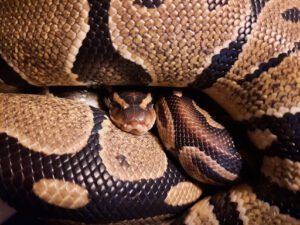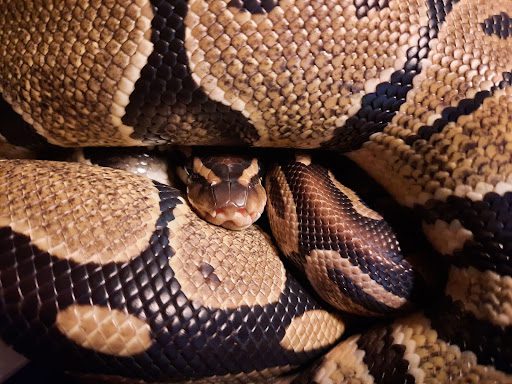
- 1 year health guarantee for all our exotic pets on sale
- [email protected]
Ball pythons, a species native to Sub-Saharan Africa, are among the most popular pet snakes due to their manageable size, docile nature, and distinctive patterns.

Photo by Mary Hinton on Unsplash
Creating an ideal habitat for a ball python in captivity is crucial for their health and well-being. This article offers comprehensive guidance on setting up a tank that mimics their natural habitat, ensuring your pet thrives in a comfortable and stimulating environment.
Creating a hospitable environment for ball pythons in captivity hinges on a thorough understanding of their natural habitat and behaviors.
By mirroring the conditions of their wild environment as closely as possible, owners can ensure their ball pythons lead healthy and stress-free lives.
Ball pythons, scientifically known as Python regius, are distinguished by their non-venomous and constrictor nature. These snakes are particularly known for their docile temperament, making them a favored choice among snake enthusiasts.
Adult ball pythons typically reach a length of 4-5 feet, which is relatively modest compared to other python species. Their distinctive defense mechanism, where they roll into a tight ball with their head tucked away in the center, is the origin of their common name. This behavior is a response to feeling threatened or stressed.
Ball pythons display a variety of color patterns and morphs, which have been selectively bred in captivity, ranging from the classic wild type to more intricate and colorful designs.
Ball pythons are indigenous to Sub-Saharan Africa, where they inhabit a range of environments including grasslands, savannas, and lightly forested areas.
These regions are characterized by a tropical climate, marked by warm temperatures and moderate humidity levels. Such conditions are crucial for the ball python’s thermoregulation and overall health.
In their natural settings, ball pythons exhibit primarily nocturnal behaviors. During the day, they seek shelter and security in burrows, under rocks, or within dense foliage. This tendency to hide is an essential aspect of their nature, driven by both the need to avoid predators and to regulate body temperature.
At night, they become more active, emerging from their hiding spots to hunt and explore. Their diet in the wild mainly consists of small mammals and birds.
Ball pythons are solitary creatures, coming together primarily for mating purposes. Understanding this solitary nature is vital when considering housing more than one python in a single enclosure, as it can lead to stress or aggression.
The ability to replicate these natural conditions and behaviors in captivity is fundamental to the well-being of ball pythons. Owners need to provide an environment that not only caters to their physical health by mimicking the temperature and humidity of their natural habitat but also respects their solitary and nocturnal nature.
This involves creating a habitat that offers ample hiding places, maintains appropriate temperature gradients, and allows for nocturnal activity, ensuring the snake feels secure and can exhibit natural behaviors.
By doing so, ball python owners can ensure their pets lead contented and healthy lives in their care.
Setting up the perfect habitat requires attention to several key elements, each playing a vital role in creating a suitable and stimulating environment for your ball python.
The tank size for an adult ball python should be at least 40 gallons, providing ample space for movement and exploration. It’s essential to have a secure, well-ventilated lid to prevent escapes and ensure proper air circulation.
Choosing the right substrate is crucial for your snake’s comfort and health. Ideal substrates for ball pythons include:
Avoid substrates like pine or cedar shavings, as they can be harmful to snakes.
Maintaining the correct temperature gradient is critical. The warm side of the tank should be around 88-92°F, while the cooler side should be about 78-80°F.
Nighttime temperatures can drop slightly but should remain above 75°F. While UVB lighting is not a necessity for ball pythons, a regular day-night cycle, achieved through natural lighting or artificial lights, is essential for their well-being.
Ball pythons require moderate humidity levels, typically between 50-60%. Regular misting, a water bowl large enough for the snake to soak in, and humidity-retaining substrates can help maintain these levels. Always ensure fresh, clean water is available.
Beyond the basic requirements, enriching your ball python’s habitat can promote natural behaviors and enhance their quality of life.
Provide at least two hides, one on the warm side and one on the cooler side of the tank. These should be snug and secure for the snake to feel safe. While not avid climbers, offering branches or ledges can encourage natural climbing behavior.
Decorations like plants (real or artificial), rocks, and branches not only make the tank more aesthetically pleasing but also provide enrichment for your snake. Arrange the tank in a way that allows the snake to explore and exercise while ensuring easy maintenance and cleaning.
Maintaining a healthy environment is as important as setting up the habitat. Regular cleaning, monitoring for signs of illness, and proper handling are essential.
Regularly clean the tank and replace the substrate to prevent the buildup of bacteria and parasites. Spot clean daily and perform a thorough cleaning monthly.
Keep an eye out for signs of illness, such as changes in eating habits, lethargy, or visible skin problems. Consistent environmental conditions are key to preventing many common health issues in ball pythons.
Handle your ball python gently and regularly to build trust and reduce stress. Avoid handling during shedding periods or shortly after feeding.
Creating the perfect habitat for a ball python involves replicating their natural environment as closely as possible while ensuring their safety and comfort.
By understanding their natural behaviors and needs, providing the right tank setup, and maintaining a clean and stimulating environment, you can ensure your ball python remains healthy and content.
The key to a happy pet snake is not just meeting their basic needs but also enriching their environment to encourage natural behaviors and provide a comfortable and engaging living space.